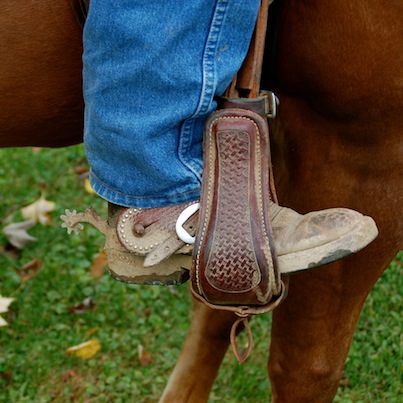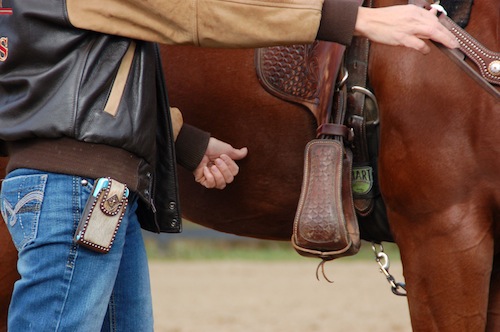I frequently get asked about the use of spurs. Do I use them? When are they appropriate? Should someone always use spurs? Will spurs make a horse dull? Hopefully, this article can shed a little light on the subject.
There are two important things to know about spurs; first — a spur is nothing more than a motivator and second, and this may be a surprise to you, spurs won’t fix your forward motion problems.
A motivator is something that encourages your horse to make a change in its behavior. Other common motivators are halters, bits, your legs while mounted and so on. We use these things to communicate with our horses, to cue them as to what it is we’re asking them to do.
For instance, when you’re leading your horse and you want it to stop; you’ll put some backward pressure on the halter. When the horse stops moving, you release the pressure. In this case, the halter is the motivator that delivers the cue to the horse. The release indicates to your horse that it has done the right thing.
If you’re riding your horse and you want more speed, you’ll first motivate by squeezing or bumping with your legs. When the speed you want is achieved, you stop the pressure. The motivator here is your leg.
But what if you want to be more precise with your request? Imagine pointing with a wave of your hand to indicate a general direction versus pointing to an exact location with your finger. That’s where the use of spurs comes in for me; they add a higher degree of accuracy in communicating with my horse because I can have more cue spots in a smaller area. They also can motivate a horse that knows what I’m asking, but is bent on being sluggish or reluctant about responding. It’s an added incentive when that spur pressure is removed.
But spurs aren’t the best answer for all horses. Consider this scenario:
Employee One arrives at work early every day, happy to be there and ready to perform a good day’s work.
Employee Two goes to work every day, but is often the last one in the door. Although slow to get going, once on the job their work can be generally good.
Employee Three gets to work late and misses entire days regularly. On the job, this employee performs poorly. Repeated reprimands have little or no effect. As time goes on, this employee does less and less each day in an effort to find out how little he can do and still pick up a paycheck.
Figure out what type of “employee” your horse is, and then find an appropriate motivator. You can’t take away your horse’s food or water (a form of paycheck), but you can take steps that an employer might take in setting consequences for inaction.
Both Employees Two and Three need to be reminded the basics of their job. If your horse falls into either of these categories, it has somehow learned that ignoring your legs is an acceptable answer. Resorting to spurs in such cases will only make your problem worse and you could even end up training your horse to ignore your spurs. These horses need to go through some of the same steps that a young horse goes through to learn forward motion. This includes everything that must happen before a horse’s first ride such as groundwork, voice cues and moving forward using a dressage whip or something similar. Then, the same lessons need to be reinforced from the saddle.
A few horses in the Employee Two category are clear about what you want but they’re slow in responding. While spurs can be of some use here, you’ll want to make sure you review the basics before you give them a try. Make sure the problem is their laziness and not their confusion about what it is you’re asking.
So when are spurs appropriate? Spurs can help to motivate your horse effectively ONLY after the horse has a thorough understanding (training level) of what it is you are asking them to do and is willingly complying (Employee One characteristics). As your horse progresses to greater levels of training, less and less pressure is required to communicate a request. Spurs, rather than being a harsher cue, can actually be gentler. With spurs, a concentrated point of light pressure can communicate what would require more pressure from a larger surface such as a heel.
When used correctly the horses don’t really mind spurs at all. The key here is “used correctly.” It is important for you to know your own limitations. Don’t use spurs if you know you might jab when you don’t intend to. And remember, using spurs when your horse doesn’t understand is like talking louder to someone who doesn’t speak your language; it doesn’t help.
Other tips
- If you have never used spurs before be sure that your horse understands that your legs mean go forward. Test this by using only your leg cues to ask your horse to walk, trot, and lope (no voice cues, whip, etc.) If your horse can’t pass this test you need to do some retraining.
- If you have never used spurs before start with the small slip on kind. This style is small enough that you will be less likely to unintentionally spur your horse. If your legs are shorter you may always need shorter shanked spurs because your foot is closer to the horse’s barrel. If you have longer legs that hang past your horses barrel you can generally get away with longer shanks because your legs are less likely to be bumping your horse’s sides.
- Using spurs will not cause you to always need spurs. Just as any other training goes you can make a horse overly dull or overly sensitive to any cue because of your timing and release.
- Not all horses need spurs. Evaluate your reasons for wanting to use them and if you are not sure consult a professional in your area for personal advice.
15 Comments
Leave a Comment

FREE PDF DOWNLOAD
WHY IS MY HORSE...?
100% Private - 0% Spam
No one taught you the skills you need to work through these things.
Riders often encounter self-doubt, fear, anxiety, frustration, and other challenging emotions at the barn. The emotions coursing through your body can add clarity, or can make your cues indistinguishable for your horse.
Learning these skills and begin communicating clearly with your horse.
Click here to learn more.



If you need Spurs, your horse doesn’t like you get a deferent horse.
[…] means that both horse and rider need to be in this stage. I wrote a whole article titled “When and why to use…or not to use…spurs” if you want the full […]
[…] love the internet. It is an amazing tool, not unlike other tools I use like bits and spurs…when they are appropriate. And the best […]
i think spurs are vary usefull in riding like for instincs when your going up a hill with your horse
[…] So, according to this survey two-thirds of us are ‘wringing our tails’ at work. Only with humans it is generally our tongues that we are ‘wringing.’ For more on horses as employees, click here. […]
I like to explain the effect of using spurs as the difference between pressing your fist into someone’s rib cage or poking with one finger. Neither are painful, but the latter will certainly get your attention better!
Awesome. To the point! Love it!
Thanks for the detailed blog it helped in more than just the spurs aspect!
Great advice for horses and employees
[…] When and why to use…or not to use…spurs.. […]
[…] Here is a GREAT article on use of spurs When and why to use…or not to use…spurs. | Stacy Westfall Horseblog […]
Stacy! Oh duhh….I had no idea. Thank you ever so much for your generous and precise
“lesson!” 🙂 Had never heard of “the thumb,” which is why God made sure we had such of
a thing & the spur in the photo looks much more *teachable* and humane! Didn’t mean to
cause a rucks, but thank you!
You are so “collected.” You know exactly what you are doing and can explain it to others succinctly.
WOW Stacy! Best article I have ever read on this topic! This answeres my questions!!!!! Thank You so much!!! YOU ROCK!
Great article! explanation complete.